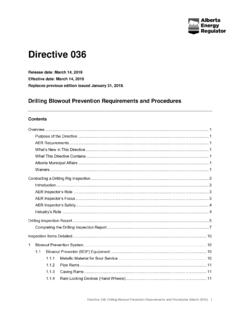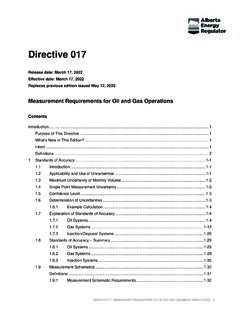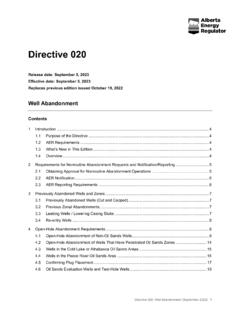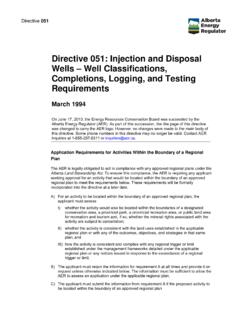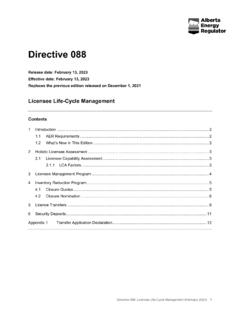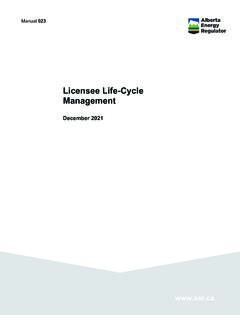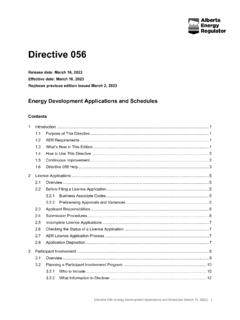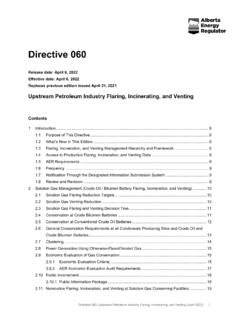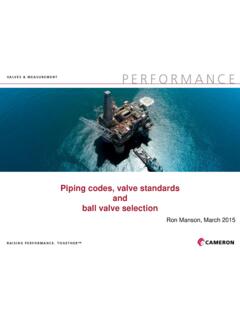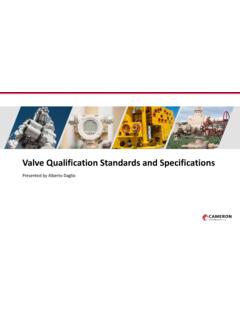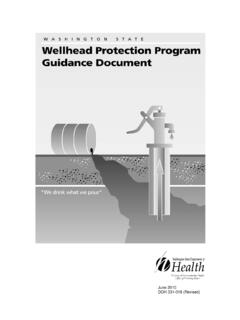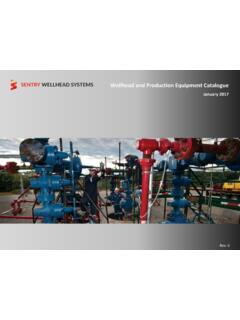Transcription of Directive 087: Well Integrity Management
1 Directive 087 Directive 087: well Integrity Management (May 2022) 1 Release date: May 11, 2022 Effective date: May 11, 2022 Replaces previous edition issued March 4, 2021 well Integrity Management Contents 1 Introduction .. 2 Purpose of This Directive .. 2 AER requirements .. 2 What s New in This Directive .. 3 Records Retention .. 3 2 Isolation Packers .. 3 Testing and Reporting .. 3 Maintaining a Triennial Testing Schedule .. 4 Testing Procedures .. 5 Repairing .. 6 3 Surface Casing Vent Flow & Gas Migration .. 7 Classification .. 7 Serious Surface Casing Vent Flow .. 7 Considered Nonserious Surface Casing Vent Flow .. 8 Nonserious Surface Casing Vent Flow .. 8 Serious Gas Migration .. 8 Nonserious Gas Migration .. 8 Reclassification of SCVF or Gas Migration .. 8 Testing .. 9 Surface Casing Vent Flow .. 9 Gas Migration .. 10 Alberta Energy Regulator 2 Directive 087: well Integrity Management (May 2022) Reporting.
2 10 Repairing .. 11 Option 1 Routine Repair Program (AER Approval Not Required) .. 12 Option 2 Nonroutine Repair Program (AER Approval Required) .. 13 Option 3 Deferral of Repair (AER Approval Required).. 13 4 Surface Casing Vent Assemblies .. 15 Exemption Criteria .. 15 5 Casing Failures .. 15 Reporting .. 16 Repairing .. 16 Appendix 1 Definitions .. 19 Appendix 2 Suggested Procedures for Testing for Surface Casing Vent Flows .. 21 Appendix 3 Suggested Procedures for Testing for Gas Migration .. 23 Appendix 4 Suggested Gas Identification Techniques and Annular Flow Testing Procedures .. 25 Table 1. minimum isolation packer testing requirements (unless otherwise specified in an AER approval) .. 4 1 Introduction Purpose of This Directive This Directive contains testing, reporting, and repair requirements for isolation packers, surface casing vent flows (SCVFs), gas migration, and casing failures. AER requirements The following AER requirements are mandatory for the responsible duty holder, as specified in legislation ( , licensee, operator, company, applicant, approval holder, or permit holder).
3 The term must indicates a requirement, while terms such as recommends and expects indicate a recommended practice. Each AER requirement is numbered. Information on compliance and enforcement can be found on the AER website, Regulating Development > Compliance > Compliance Assurance Program. Alberta Energy Regulator Directive 087: well Integrity Management (May 2022) 3 What s New in This Directive The following changes have been made to this edition of the Directive : Section : Added a definition for packer isolation test. In table 1, for the Class 1a well , clarified that during the packer isolation test, the approved maximum wellhead injection pressure is not to be exceeded. Section : Clarified that when a packer has been repaired, reset, or replaced, the packer isolation test needs to adhere to Directive 051: Injection and Disposal Wells well Classifications, Completions, Logging, and Testing requirements . Records Retention 1) The licensee must keep all testing, monitoring, and repair records created or collected under this Directive for the life of the well plus two years, unless otherwise authorized by the AER.
4 2) The AER may at any time require licensees to produce any documentation required under this Directive . 2 Isolation Packers Questions about this section should be submitted to Testing and Reporting A packer isolation test means a pressure test of the tubing and casing annulus designed to evaluate the Integrity of the wellhead , casing, tubing, and packer. 3) Effective January 1, 2021, licensees must conduct isolation packer testing as per table 1, unless other testing requirements are specified in an AER approval. 4) The test results must be reported through the designated information submission system between January 1 and December 31, within the same calendar year the test was performed. 5) Licensees are responsible for interpreting and reporting test results. 6) An isolation packer test record must contain all of the information contained in sections and of this Directive for each well tested. A packer test form is available on our website.
5 Alberta Energy Regulator 4 Directive 087: well Integrity Management (May 2022) Table 1. minimum isolation packer testing requirements (unless otherwise specified in an AER approval) well type Test schedule minimum pressure test length (minutes)* minimum test pressure (kPa) Production well with H2S greater than 50 moles per kilomole, unless the well is produced by artificial lift annual 15 1400 Injection and disposal wells Class 1a annual 15 The greater of 7000 kPa or times the wellhead injection pressure (not exceeding the approved maximum wellhead injection pressure) Class 1b (including Class II/1b) annual 15 1400 Class II (including Class II/IV) triennial 15 1400 Class III (including Class II/III) annual 15 1400 Acid gas annual 15 1400 The AER publishes a list of wells each calendar year that are potential candidates for packer isolation testing through the designated information submission system. This list is not to be relied on as complete and is only to be used as a guide.
6 Licensees are responsible for knowing their inventory and ensuring that all packer testing requirements are met. Testing requirements for the initial placement of packers for injection and disposal wells is specified in Directive 051. After initial placement, for all wells where a packer is required, the packer must remain in the wellbore, be tested for the life of the well , and meet all requirements of this Directive until suspension requirements of Directive 013: Suspension requirements for Wells or abandonment requirements of Directive 020: well Abandonment are met, or the well is converted to a well type where a packer is no longer required. Maintaining a Triennial Testing Schedule Annual means at least once every calendar year (January 1 to December 31). Triennial means at least once every three calendar years. 7) Where a triennial testing frequency is permitted (see table 1), a licensee must do all of the following: a) Develop an effective program to monitor well Integrity between packer isolation tests.
7 B) Provide documentation of the (corporate or site specific) monitoring program to the AER upon request. Alberta Energy Regulator Directive 087: well Integrity Management (May 2022) 5 c) Investigate any indications of well Integrity failure such as continuous or sudden pressure changes, annular fluid level changes, or anomalies that may indicate a well Integrity failure between triennial tests. It is recommended that, between packer isolation tests, licensees record, at a minimum , monthly tubing and casing pressures to track any pressure changes that may be indicative of a failure. Testing Procedures 8) For the duration of the pressure test, the pressure must never drop below the minimum listed in table 1, and the rate of the pressure change must show a decreasing trend towards stabilization. Rate of change means the amount of pressure change over a 1- minute period trended throughout the pressure test. Licensees should conduct packer isolation tests at as close as practical to normal operating well conditions.
8 9) The maximum overall pressure change for the test duration must not exceed 50 kPa to be considered satisfactory. 10) Licensees must conduct and record packer isolation tests using calibrated (as per manufacturers specifications) digital pressure gauge equipment that has a minimum resolution of kPa. The data must be collected by using digital pressure gauge equipment with data logging capability or by manually recording the data. Digital pressure gauges with data logging capabilities must be set to record at a minimum interval of 15 seconds ( minimum four times per minute), and manually recorded data must be recorded at a minimum interval of one reading per minute for the duration of the test. The use of rotary chart equipment for packer isolation testing is not accepted. 11) Licensees must conduct packer isolation tests using the procedures provided below for the applicable case. Case 1 Casing pressure >1400 kPa prior to bleed down Record initial casing and tubing pressures.
9 Bleed the casing pressure off and record the bleed-off volume and the types of any gas or fluid recovered. Volumes may be estimated where measurement is impractical. Record the shut-in casing pressure after a minimum of 24 hours. To be considered satisfactory, the pressure change over a 24-hour period must not exceed 50 kPa. Alberta Energy Regulator 6 Directive 087: well Integrity Management (May 2022) Case 2 Casing pressure 1400 kPa prior to bleed down Record initial casing and tubing pressures. Bleed the casing pressure off and record the bleed-off volume and the types of any gas or fluid recovered. Volumes may be estimated where measurement is impractical. Pressure test the casing annulus as described in table 1 and record the annular fill volume. Bleed the casing pressure off and record the shut-in casing pressure after a minimum of 24 hours. To be considered satisfactory, both the pressure change during the 15-minute pressure test and the pressure change over a 24-hour period must not exceed 50 kPa.
10 Case 3 No initial casing pressure Record initial casing and tubing pressures. Pressure test the casing annulus as described in table 1 and record the annular fill volume. Bleed the casing pressure off. To be considered satisfactory, the pressure change during the 15-minute pressure test must not exceed 50 kPa. Case 4 Licensee designed test customized for well operations Test procedures must effectively identify any well Integrity concerns or potential failures in the tubing, casing, packer seal, or wellhead seal assembly; meet the minimum pressure and duration requirements specified in table 1 when pressure testing; and be documented. Repairing 12) Any failure identified through a packer isolation test, site visit, or triennial monitoring program must be reported through the designated information submission system within 30 days of detection. 13) Upon detection, licensees must investigate failures and complete necessary remedial work and retest for hydraulic isolation.
